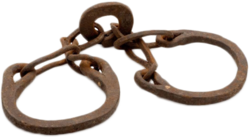
Back العبودية في الصين Arabic Esclavage en Chine French עבדות בסין HE 中国の奴隷制 Japanese Escravidão na China Portuguese Slaveri i Kina Swedish
| Part of a series on |
| Forced labour and slavery |
|---|
 |

Slavery in China has taken various forms throughout history. Slavery was nominally abolished in 1910,[3][4][5] although the practice continued until at least 1949.[6] The Chinese term for slave (simplified Chinese: 奴隶; traditional Chinese: 奴隸; pinyin: núlì) can also be roughly translated into 'debtor', 'dependent', or 'subject'. Despite a few attempts to ban it, slavery existed continuously throughout pre-modern China, sometimes serving a key role in politics, economics, and historical events. However slaves in China were a very small part of the population due to a large peasant population that mitigated the need for large scale slave labor. The slave population included war prisoners and kidnapped victims or people who had been sold.[7]: 145–147 [8]
- ^ "女".
- ^ "Chinese character component 女 woman (meaning) - Ninchanese".
- ^ Hallet, Nicole. "China and Antislavery Archived 2014-08-17 at the Wayback Machine". Encyclopedia of Antislavery and Abolition, Vol. 1, p. 154 – 156. Greenwood Publishing Group, 2007. ISBN 0-313-33143-X.
- ^ Gang Zhou. Man and Land in Chinese History: an Economic Analysis Archived 12 April 2016 at the Wayback Machine, p. 158. Stanford University Press (Stanford), 1986. ISBN 0-8047-1271-9.
- ^ Huang, Philip C. Code, Custom, and Legal Practice in China: the Qing and the Republic Compared Archived 17 August 2014 at the Wayback Machine, p. 17. Stanford University Press (Stanford), 2001. ISBN 0-8047-4110-7.
- ^ Rodriguez, Junius. "China, Late Imperial Archived 2014-08-17 at the Wayback Machine". The Historical Encyclopedia of World Slavery, Vol. 1, p. 146. ABC-CLIO, 1997. ISBN 0-87436-885-5.
- ^ Cite error: The named reference
medievalwas invoked but never defined (see the help page). - ^ Schottenhammer, Angela (1 August 2003). "Slaves and Forms of Slavery in Late Imperial China (Seventeenth to Early Twentieth Centuries)". Slavery & Abolition. 24 (2): 143–154. doi:10.1080/01440390308559161. ISSN 0144-039X. S2CID 143643161.
© MMXXIII Rich X Search. We shall prevail. All rights reserved. Rich X Search